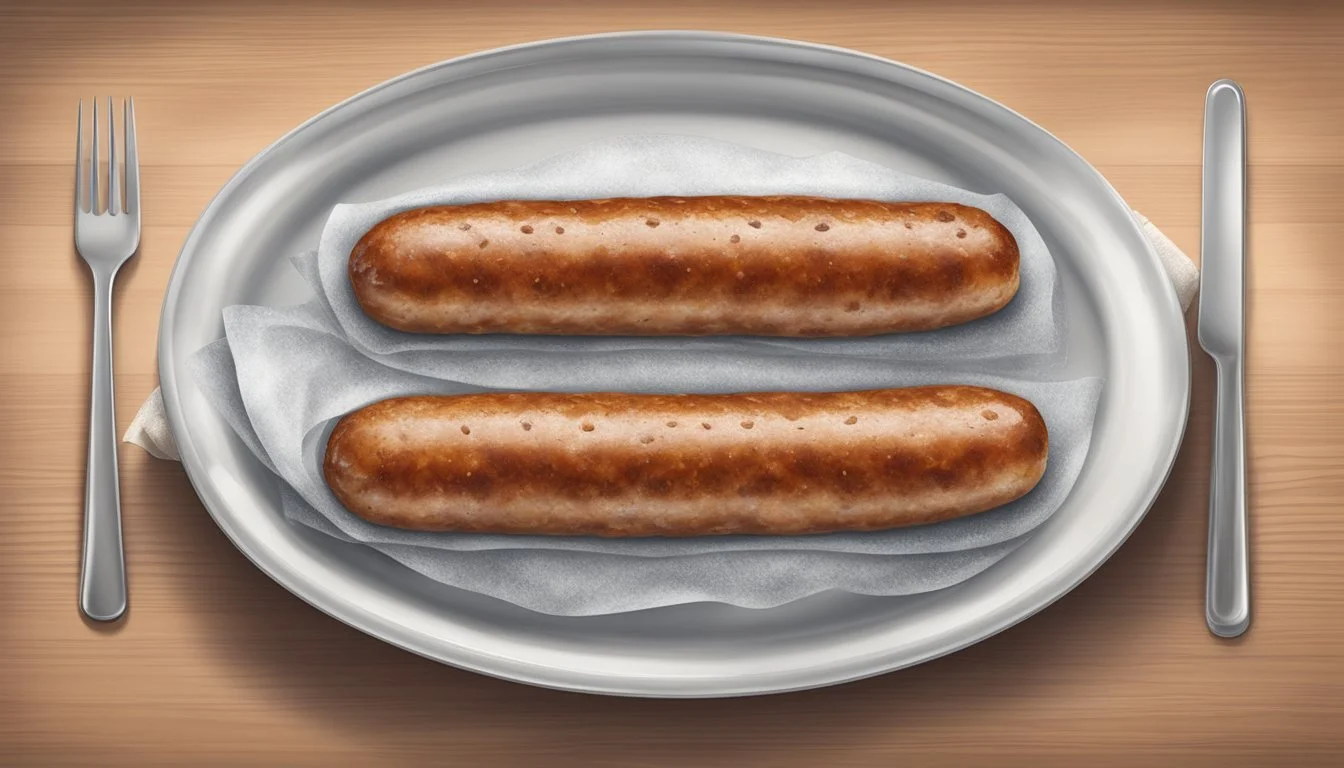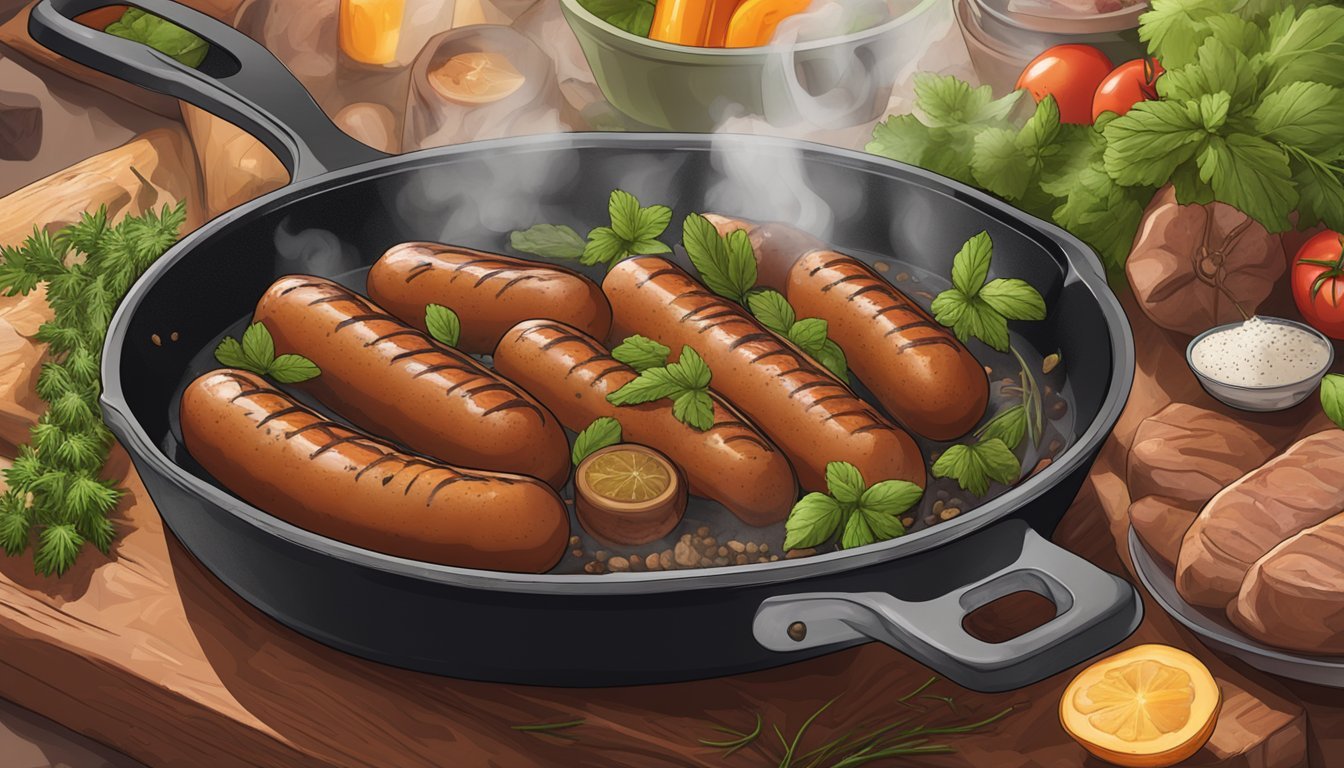Best Way to Reheat Nuremberger Sausage
Ensuring Juiciness and Tenderness
Nuremberger sausages, with their rich flavor and delicate texture, are a cherished delicacy originating from the German city of Nuremberg. When prepared freshly, they offer a juicy and tender bite, but maintaining that same quality upon reheating can be challenging. To keep reheated Nuremberger sausages from becoming dry or tough, it's essential to use a method that ensures they stay moist and retain their original taste.
The key to reheating these sausages lies in a gentle and even application of heat, allowing the internal temperature to rise without overcooking the exterior. Techniques such as oven-warming, steaming in a pan, or even a low-heat grilling process can help achieve this balance. Wrapping the sausages in foil or using a covered dish when using the oven, or adding a small amount of water to the pan when steaming, can help lock in the sausages’ natural juices. By carefully managing the reheating process, one can recreate the delightful experience of a freshly cooked Nuremberger sausage.
Understanding Nuremberger Sausage
The Nuremberger sausage, a gem in the world of German cuisine, is treasured for its unique flavor and texture. This section unveils the sausage's rich history and distinct characteristics that contribute to its gourmet status.
History and Origin
Nuremberger sausages have been a cornerstone of culinary tradition in Nuremberg, a city with a profound historical significance. Records indicate that a position for a sausage supervisor, or Würstlein, was established as early as 1315, reflecting the sausage's integral role in the city's gastronomy. Over centuries, the recipe for these sausages was refined, leading to the distinctive Nuremberger we know today, once slim enough to fit through a keyhole according to historic tales.
Characteristics and Flavor Profile
Texture and Flavor: The Nuremberger sausage is renowned for a blend of flavorful spices including mace, pepper, and marjoram, which imparts a savory taste profile with hints of herbal warmth. Its fine texture is achieved with precision in the grinding process of pork, ensuring a juicy bite.
Cooking Method for the Ideal Texture: When reheated properly, the Nuremberger sausage retains its juicy interior and develops a crispy exterior. Gently cooking in water at 78°C maintains its moisture, while finishing in a pan or oven can enhance its crispness.
By appreciating its historic roots and distinct taste and texture, one can fully understand the culinary delight that is the Nuremberger sausage.
Preparation Basics Before Reheating
Proper preparation prior to reheating Nuremberger sausages is crucial to maintain their juiciness and tenderness. Starting with correctly thawed sausages and a preheated oven ensures optimal results.
Thawing Properly
If the sausages are frozen, they should be thawed completely before reheating to prevent uneven heating and to retain their texture. To thaw:
Fridge: Place the sausages in the refrigerator overnight.
Cold Water: Submerge in cold water, changing it every 30 minutes.
Preheating Essentials
Preheating the oven before reheating the sausages is essential to provide a consistent heating environment. Here’s how:
Temperature: Set the oven to a moderate temperature such as 325°F (165°C).
Preheat Time: Allow the oven to preheat fully, usually taking about 10-15 minutes.
By following these foundational steps, one ensures the sausages are not subjected to thermal shock, which could impair their quality, and that they are brought up to a safe and enjoyable eating temperature evenly.
Reheating Methods
When reheating Nuremberger sausage, maintaining moisture and ensuring even heating are key to preserving its juiciness and tenderness. Various methods are available to achieve this while considering the tools at hand and time constraints.
Stovetop Technique
One can reheat sausages on a stovetop using a skillet or frying pan. First, add a thin layer of water to the pan and let it simmer over medium-low heat. Place the sausages in the pan, cover them to contain the steam, and turn them periodically to ensure even reheating. The steam helps maintain moisture. Aim for an internal temperature of 165°F as a safe reheating benchmark.
Oven Method
Reheating in the oven involves preheating it to 325°F and wrapping each sausage in aluminum foil to seal in moisture. Place the foil-wrapped sausages on a baking sheet and heat them until warmed throughout; this usually takes 10-15 minutes. The foil prevents drying out and allows for gentle heating.
Microwave Strategy
For a quick option, sausages can be microwaved. Arrange them on a microwave-safe dish, cover with a damp paper towel to add moisture, and use a medium-high setting to avoid overcooking. Heat in short intervals of 30 seconds, checking the temperature after each burst to avoid overheating.
Air Fryer Approach
An air fryer provides a rapid reheating method that circulates hot air around the sausage, promoting even cooking. Lightly coat the sausages in oil, place them in the air fryer basket without overcrowding, and heat at 350°F for about 4-6 minutes. Be sure to turn the sausages halfway through to ensure proper heating.
Tips for Juiciness and Flavor Retention
The key to reheating Nuremberger sausage successfully lies in controlling moisture and heat. Proper techniques ensure the sausages remain juicy and flavorful.
Wrapping and Moisture Control
To retain moisture during reheating, one should wrap Nuremberger sausages securely. Aluminum foil is the ideal material for this task; it traps moisture and prevents the sausages from drying out. For an additional moisture boost, one can also baste the sausages with a bit of beef broth or any other cooking liquid, which will contribute to a flavorful end result.
Steps for Wrapping:
Lay out a sheet of aluminum foil.
Place the sausages on the foil.
Add a tablespoon of cooking liquid.
Securely wrap the foil around the sausages.
Temperature and Timing
The optimal temperature range for reheating sausages is between 250°F and 300°F. This low and slow approach is crucial for preventing the loss of juiciness. Nuremberger sausages should be reheated until they reach an internal temperature of 165°F, which is considered safe for consumption. The use of an oven or stovetop at these temperatures helps to heat the sausage gently, maintaining its tenderness and preventing any flavor loss.
Temperature Guidelines:
Preheat to 250°F - 300°F.
Heat until the internal temperature reaches 165°F.
Additional Reheating Considerations
Before reheating Nuremberger sausages, it's crucial to consider the utensils used and food safety measures. Using appropriate tools and adhering to temperature guidelines can affect not only the flavor and texture but also the safety of the meal.
Selecting the Right Utensils
Choosing the correct utensils for reheating Nuremberger sausages is vital for preserving their juicy and tender quality. Using tongs rather than a fork can help avoid piercing the sausage casings, which can cause juices to escape and lead to dryness. Furthermore, for measuring the internal temperature, a meat thermometer is indispensable to ensure the sausage is heated evenly without overcooking. When using a microwave, arranging the sausages on a microwave-safe plate and covering them with a damp towel helps retain moisture.
Food Safety Measures
Food safety is paramount when reheating any meat product to prevent food poisoning. The sausage should reach an internal temperature of 165°F (74°C) which is the safe temperature for leftover foods as recommended by food safety authorities. Utilizing a meat thermometer can provide an accurate reading to assure that this temperature is achieved. It is important to not only avoid undercooking, as it poses health risks, but also not to overcook the sausages, which can compromise their texture and moistness.
Serving Suggestion and Accompaniments
Perfectly reheated Nuremberger sausage offers a succulent and tender bite, enhanced by an array of accompaniments. Proper serving temperature and select sides can elevate the dining experience significantly.
Optimal Sausage Serving Temperature
The Nuremberger sausage is best served warm, with an internal temperature of approximately 71-73°C (160-165°F), ensuring that it retains its juices and tenderness. Before serving, allowing the sausage to rest for a minute or two ensures that the heat distributes evenly, maintaining its juicy quality.
Sides and Condiments
The classic accompaniments to Nuremberger sausage include a variety of sides and condiments, carefully chosen to complement its flavors:
Mustard: A staple with sausages, especially a robust Dijon or Bavarian sweet mustard, can accentuate the meat's flavors without overwhelming them.
Relish: Whether it's a traditional German sauerkraut or a tangy pickled relish, these add a pleasant acidity that cuts through the fat, balancing the sausage's richness.
Ketchup: Although not traditional, some diners prefer the sweetness of ketchup to contrast with the savory notes of the sausage.
Sides: For a wholesome meal, pair the sausages with:
Sauerkraut: for a tangy contrast,
Potato salad: for a creamy complement,
Roasted vegetables: for a healthy balance,
Pretzels: for a hearty traditional accompaniment.
Each condiment and side dish is selected to enhance the Nuremberger sausage's juicy and tender profile while providing a balanced and full-flavored meal.
Frequently Asked Questions
How can one best reheat Nuremberger sausages to maintain their juiciness?
To retain juiciness, Nuremberger sausages should be reheated slowly and at a moderate temperature. Wrapping them in aluminum foil or using an oven-safe dish with a lid can help keep the moisture in. An oven preheated to 350°F (175°C) is ideal for reheating.
What is the best method to store leftover sausages?
Leftover sausages should be stored in an airtight container in the refrigerator. To prevent them from sticking together or losing moisture, individual sausages can be wrapped in plastic wrap before placing them in the container.
Can sausages be reheated in a microwave?
Reheating in a microwave is quick but can unevenly heat sausages and potentially cause them to burst. If using a microwave, cover the sausages with a damp paper towel and reheat at medium power, checking for even warmth.
Is it possible to keep the sausages crispy when reheating?
To maintain crispiness, sausages should be reheated in an oven or on a stove top. Controlled browning on a pan can help achieve a golden brown, crispy exterior. Use medium heat and turn sausages regularly.
How should one handle different thicknesses or types of sausages when reheating?
Thicker or denser sausages such as smoked sausage may require longer reheating times. Chicken sausages, being lower in fat, require careful reheating to prevent drying out. Adjust times and temperatures based on thickness and sausage type.
Can I reheat sausages together with accompaniments like peppers?
When reheating sausage and peppers or sausage casserole, ensure even heating by cutting sausages into smaller pieces if necessary. Use a covered baking dish in the oven for an even distribution of heat.
Is grilling a good method for reheating sausages?
Reheating by grilling should be done with care to avoid charring and bursting. It can lend sausages a savory sear and restore the flavors of outdoor cooking. Turn regularly to prevent overheating.
What should one avoid when reheating sausages to prevent them from becoming tough?
Avoid high heat and overcooking as they can cause the sausages to become tough and lose moisture. Gentle reheating is key. Check the internal temperature to ensure it’s warmed through without overdoing it.






